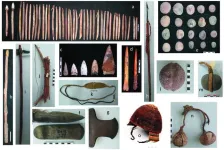(Press-News.org) CAMBRIDGE, MA -- For diabetes patients who must give themselves frequent insulin injections, the risk of low blood sugar can be life-threatening. A potential solution is a type of engineered insulin that circulates in the body and springs into action only when needed. Researchers working on this type of “glucose-responsive insulin” (GRI) hope that it could be injected less often and help the body maintain normal blood sugar levels for longer periods of time.
To help in the efforts to develop this kind of insulin, MIT engineers have created a computational model that predicts how the human body will respond to different versions of GRIs. Their model is unique in that it can also compare the human response to those of lab animals used for preclinical testing of GRIs.
In a new study, the MIT team used the model to analyze the results of a recent GRI clinical trial that was discontinued because the drug showed little effect in humans. Their analysis found that the drug, which had worked well in animal studies, acted differently in the human body because of differences in the behavior of a sugar receptor that helps to control the drug’s action.
Using this model, researchers could design novel GRIs and obtain better predictions of whether a particular GRI would work in humans before launching a costly clinical trial.
“This model can help with the design process and also help to predict human performance, which I think is going to de-risk the investment of taking these types of drugs to clinical trials,” says Michael Strano, the Carbon P. Dubbs Professor of Chemical Engineering at MIT and the senior author of the new study, which appears today in ACS Pharmacology and Translation.
Jingfan Yang PhD ’22 is the lead author of the paper, working with current graduate student Sungyun Yang.
Modeling glucose response
In recent years, many drug companies have been working on glucose-responsive insulins, which are activated in response to high blood sugar levels. In 2016, the pharmaceutical company Merck ran a phase I clinical trial of a GRI called MK-2640, which had shown promising results in preclinical studies performed in animals.
“This drug, if it were to show efficacy in clinical trials and then go to the market, would have helped diabetics because it’s a therapeutic that can activate as their blood sugar rises,” Strano says. “This gives them a better degree of control and can provide protection against hypoglycemia or dangerously low blood sugar.”
MK-2640 was designed with a novel glucose-response mechanism known as competitive clearance. The insulin is engineered so that it binds to cell receptors that normally bind to a sugar called mannose. When blood sugar levels are low, GRI molecules bind to these receptors and are cleared from the body. However, when blood sugar rises, the GRI is blocked from binding to the receptors and stays in the bloodstream, where it helps to reduce sugar levels.
“This is a great way of building pancreatic function into the drug. It’s been a longstanding goal of the diabetes community to make a drug that operates in this way,” Strano says. “The drug performed very well in animals, but when it was tried in humans, it showed a really lackluster effect.”
Around the same time, Strano’s lab was developing a way to computationally model the glucoregulatory system of humans and other animals. The model consists of a set of equations that describes how glucose and insulin behave in different compartments of the human body, such as blood vessels, muscle, and fatty tissue. This allows them to predict blood glucose levels in organs including the liver, stomach, and brain, for a variety of species, including humans.
“This is a very detailed model, and it has parameters that have been tuned with extensive clinical data and animal data, so it’s able to faithfully recreate experiments that researchers do on both humans and animals,” Strano says.
For example, the model can be used to predict how blood sugar levels will change after a meal, or what will happen if glucose is infused into the body, based on how much insulin is available. His lab has previously used this model to predict the behavior of a different type of glucose-responsive insulin, which is coated with molecules called PBA that bind to glucose and activate insulin.
Designing better drugs
After the Merck trial ended, Strano and his students decided to see if their computational model could generate any insight into why the drug did not perform as expected. They applied it to all of the data available on the glucoregulatory system of Yucatan minipigs, the animal model used for some of the Merck preclinical studies.
Using the computational model, the researchers found that interspecies differences in the clearance capacity of the mannose receptor accounted for the weak performance of the GRI in human trials. Because of that difference, GRI levels did not change significantly in humans compared to animals when glucose levels changed.
“It’s really a failure of animal models to capture an important element of the mechanism in humans,” Strano says.
The model also showed that if the human version of the mannose receptor were tuned to perform similarly to that of the minipigs, the drug would likely have performed much better in clinical trials.
The researchers have made their model open source so that others can use it to explore potential GRIs that might work better, and to evaluate whether drugs that have shown promise in animal studies would also work well in humans. Strano’s lab is also working on such drugs, in collaboration with Michael Weiss, chair of the Department of Biochemistry and Molecular Biology at Indiana University, who is also an author of the ACS Pharmacology and Translation study.
Strano’s lab is also working on another version of the model that would incorporate the effects of glucagon, a hormone that increases blood sugar and can prevent life-threatening hypoglycemia. Researchers have theorized that treating diabetic patients with a combination of insulin and glucagon could offer better control of blood sugar levels than insulin alone.
The general approach of designing drugs that respond to conditions inside the body could also be beneficial for treating a wide variety of other diseases, Strano says.
“This could lead to a new generation of drugs that don’t just passively circulate within the body and wait to operate, but are tuned to reach a certain therapeutic endpoint and regulate their potency accordingly,” he says.
###
The research was funded by the National Institutes of Health and the Helmsley Charitable Trust. Other authors of the paper include Research Scientist Xun Gong, Naveed Bakh PhD ’19, Ge Zhang PhD ’22, Allison Wang ’21, and Alan Cherrington, a professor of molecular physiology and biophysics at Vanderbilt University.
END
Computational model helps with diabetes drug design
Researchers can use the model to predict how engineered forms of insulin would perform in human patients, making it easier to bring these drugs to clinical trials.
2023-09-20
ELSE PRESS RELEASES FROM THIS DATE:
Lungs play a critical role in fetal blood development, new study from Boston Medical Center and Boston University’s Center for regenerative medicine finds
2023-09-20
BOSTON – A newly-released study by Boston Medical Center (BMC) and Boston University’s Center for Regenerative Medicine (CReM) found that the fetal lung is a potential source of hemogenic endothelial cells (HECs) that have the capacity to make blood. The findings broaden the understanding of where and how blood forms, which has the potential to enhance the treatment of blood-related diseases such as leukemia and lymphoma. Previously, no lung HECs had ever been detected.
“Our findings show that hemogenic endothelium, which was previously thought to be restricted to ...
LSU receives $5M from NOAA to build high-frequency radar systems on the coast
2023-09-20
From energy production to recreational fishing, Louisiana’s coastal waters are a busy place. Having reliable data about oceanic conditions can be critical to safe operations for those who work and play in coastal waters. Up until now, Louisiana’s Gulf Coast has been hampered by a lack of high-quality information about currents, waves and other important factors.
A new, LSU-led high-frequency radar project will change that.
This $5 million, NOAA (National Oceanic and Atmospheric Administration) funded project will install up to eight high-frequency radar, or HF radar, systems along the Louisiana coastline. Spearheaded by the ...
Texas Biomed launches new International Center for the Advancement of Research & Education
2023-09-20
SAN ANTONIO (Sept. 20, 2023) – Capitalizing on the power of its longstanding international partnership portfolio, Texas Biomedical Research Institute (Texas Biomed) has created a new global center to foster collaborations in infectious disease research.
The International Center for the Advancement of Research & Education (I·CARE) leverages the power of global exchange to solve complex health issues in an increasingly connected world. Texas Biomed currently maintains a portfolio of more than 15 international partnerships across Latin America, Africa, Asia and Europe. These partnerships are driving research in ...
Dolphins, seals, and whales managed by the US are highly vulnerable to climate change
2023-09-20
72% of cetacean and pinniped stocks managed under US jurisdiction are highly or very highly vulnerable to climate change, according to a study published in PLOS ONE led by Matthew D. Lettrich at NOAA Fisheries, in Silver Spring, Maryland, United States of America.
Climate change could affect the distribution, behavior, and movements of marine mammals via warming ocean temperatures, rising sea levels, decreasing dissolved oxygen, declining sea ice coverage, ocean acidification, and salinity changes. Climate vulnerability assessments (CVAs) provide a framework for evaluating climate impacts over a broad range of species. Prior to the study, no known CVAs specifically assessed US-managed ...
Ancient human remains buried in Spanish caves were subsequently manipulated and utilized
2023-09-20
Caves served as sites for burial and later modification of human remains for thousands of years in the Iberian Peninsula, according to a study published September 20, 2023 in the open-access journal PLOS ONE by Zita Laffranchi and Marco Milella of the University of Bern, Switzerland, and Rafael Martinez Sanchez, Universidad de Córdoba, Spain, and colleagues.
The use of caves as burial sites is a cultural phenomenon with a broad distribution in both space and time. In the southern Iberian Peninsula, this practice became particularly ...
Long-term history of violence in hunter-gatherer societies uncovered in the Atacama Desert
2023-09-20
Interpersonal violence was a consistent part of life in ancient hunter-gatherer communities on the Atacama Desert coast of northern Chile, according to a study published September 20, 2023 in the open-access journal PLOS ONE by Vivien Standen of the University of Tarapacá, Chile and colleagues.
Archaeological research supports the notion that interpersonal violence and warfare have played an important role in the lives of hunter-gatherer groups over time, but many questions remain about the factors that influence such violence. The record of ...
US political donations are associated with policy issues prioritized in congressional speeches
2023-09-20
The first comprehensive analysis of the relationship between campaign donations and the issues legislators prioritize with congressional speech is published in the open access journal PLOS ONE this week. While prior research reaches mixed conclusions on associations between political donations in the US and voting patterns of legislators, this research suggests there are substantial associations between donations and policy priorities expressed in congressional speeches, and marks language use as an interesting and viable arena for looking at the impact political donors may have on congressional behavior.
Publicly traded corporations and labor unions in the US routinely raise funds ...
Job ads which use masculine rather than gender-inclusive language are perceived by women as sexist, leading them to feel ostracized, demotivated, and as though they don't belong at work
2023-09-20
Job ads which use masculine rather than gender-inclusive language are perceived by women as sexist, leading them to feel ostracized, demotivated, and as though they don't belong at work
###
Article URL: https://journals.plos.org/plosone/article?id=10.1371/journal.pone.0290709
Article Title: The impact of gender-exclusive language on women’s anticipated ostracism: A preregistered replication of Stout and Dasgupta (2011)
Author Countries: USA
Funding: Miami University Committee on Faculty Research, Heather M. Claypool Miami University College of Arts and Science, Heather M. Claypool. END ...
Only 1% of US kids who are obese in elementary school transition to a healthy weight within two years, although 1 in 4 overweight children progress to a healthy weight range
2023-09-20
Only 1% of US kids who are obese in elementary school transition to a healthy weight within two years, although 1 in 4 overweight children progress to a healthy weight range
###
Article URL: https://journals.plos.org/plosone/article?id=10.1371/journal.pone.0290565
Article Title: Weight trajectories and obesity remission among school-aged children
Author Countries: USA
Funding: Research reported in this publication was supported by the National Institute of Diabetes And Digestive And Kidney Diseases of the National Institutes of ...
Suppressing negative thoughts may be good for mental health after all, study suggests
2023-09-20
The commonly-held belief that attempting to suppress negative thoughts is bad for our mental health could be wrong, a new study from scientists at the University of Cambridge suggests.
Researchers at the Medical Research Council (MRC) Cognition and Brain Sciences Unit trained 120 volunteers worldwide to suppress thoughts about negative events that worried them, and found that not only did these become less vivid, but that the participants’ mental health also improved.
“We’re all familiar with the Freudian idea that if we suppress our feelings or thoughts, then these thoughts remain in our unconscious, influencing our behaviour and wellbeing ...
LAST 30 PRESS RELEASES:
Eye for trouble: Automated counting for chromosome issues under the microscope
The vast majority of US rivers lack any protections from human activities, new research finds
Ultrasound-responsive in situ antigen "nanocatchers" open a new paradigm for personalized tumor immunotherapy
Environmental “superbugs” in our rivers and soils: new one health review warns of growing antimicrobial resistance crisis
Triple threat in greenhouse farming: how heavy metals, microplastics, and antibiotic resistance genes unite to challenge sustainable food production
Earthworms turn manure into a powerful tool against antibiotic resistance
AI turns water into an early warning network for hidden biological pollutants
Hidden hotspots on “green” plastics: biodegradable and conventional plastics shape very different antibiotic resistance risks in river microbiomes
Engineered biochar enzyme system clears toxic phenolic acids and restores pepper seed germination in continuous cropping soils
Retail therapy fail? Online shopping linked to stress, says study
How well-meaning allies can increase stress for marginalized people
Commercially viable biomanufacturing: designer yeast turns sugar into lucrative chemical 3-HP
Control valve discovered in gut’s plumbing system
George Mason University leads phase 2 clinical trial for pill to help maintain weight loss after GLP-1s
Hop to it: research from Shedd Aquarium tracks conch movement to set new conservation guidance
Weight loss drugs and bariatric surgery improve the body’s fat ‘balance:’ study
The Age of Fishes began with mass death
TB harnesses part of immune defense system to cause infection
Important new source of oxidation in the atmosphere found
A tug-of-war explains a decades-old question about how bacteria swim
Strengthened immune defense against cancer
Engineering the development of the pancreas
The Journal of Nuclear Medicine ahead-of-print tip sheet: Jan. 9, 2026
Mount Sinai researchers help create largest immune cell atlas of bone marrow in multiple myeloma patients
Why it is so hard to get started on an unpleasant task: Scientists identify a “motivation brake”
Body composition changes after bariatric surgery or treatment with GLP-1 receptor agonists
Targeted regulation of abortion providers laws and pregnancies conceived through fertility treatment
Press registration is now open for the 2026 ACMG Annual Clinical Genetics Meeting
Understanding sex-based differences and the role of bone morphogenetic protein signaling in Alzheimer’s disease
Breakthrough in thin-film electrolytes pushes solid oxide fuel cells forward
[Press-News.org] Computational model helps with diabetes drug designResearchers can use the model to predict how engineered forms of insulin would perform in human patients, making it easier to bring these drugs to clinical trials.






